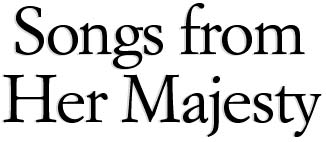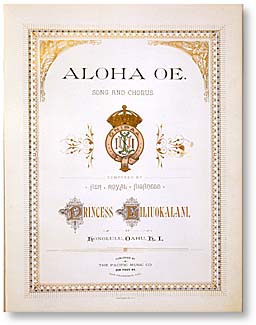



Queen Lili'uokalani wanted
By Cynthia Oi
her music to be accessible to all,
and after 26 years of Hui Hanai's
effort her wish will come true
Star-BulletinDOZENS OF VOICES WILL BE singing through the pages of "The Queen's Songbook" when the book is released this week.
None will be more joyous than those of Dr. Kekuni Blaisdell, Agnes Conrad and Barbara Smith. They are just three of the many people who have researched, edited and arranged music for the book that celebrates the creativity of Queen Lili'uokalani, Hawaii's last sovereign.
The songbook contains 55 of Lili'uokalani's compositions, 42 of which have never been in print or published in a particular form before. Five other songs closely associated with the queen also are included in the collection, along with an essay on Lili'uokalani and her music, historical commentary, translations, chronologies and photographs.
The book is a project of Hui Hanai, an organization formed in 1969 as an auxiliary to the Queen Lili'uokalani Children's Center. Hui Hanai in 1973 decided to collect and publish the queen's works to perpetuate her memory.

"The queen herself intended to do this, so we are carrying out her expressed desire and vision to make available her songs to every Hawaiian family," Blaisdell said. "The book is the final fruition after, lo, these 26 years."
Several public events will celebrate the release of "The Queen's Songbook": DEBUT
Hula and mele by the Ladies of Malanai and the 'Iolani Palace 'Ukulele Band, 12:30 p.m. Thursday, 'Iolani Palace
Mele by Na Leo Kuho'okahi of the Hawai'i Youth Opera Chorus, dramatic reading by Puanani Higgins, 5 p.m. Thursday , Native Books & Beautiful Things, 222 Merchant St.
Sing-along, 4 p.m. Oct. 23, Ward Centre Amphitheatre
BOOK NOTES:
What:"The Queen's Songbook" by Her Majesty Queen Lili'uokalani
Where:Available Oct. 7 at Native Books, Kapalama; Native Books & Beautiful Things, 222 Merchant St. and Ward Centre Also at 'Iolani Palace, Mission Houses Museums, Queen Emma Summer Palace, Bishop Museum, Kawaiaha'o Church, Nake'u Awai, House of Music, BookEnds and Bestsellers
Cost: $48, clothbound; $35 paperbound
Call: 955-5256
Lili'uokalani was considered an accomplished composer and musician. She played the piano, organ, ukulele, guitar and zither, and was an expert in sight-reading music, according to historical accounts.
In 1897, she prepared for publication a manuscript that was never published, "He Buke Mele Hawaii," consisting of 110 songs, melodies and translations.
"I want to get this work out in good shape, so that my enemies may see that I am more intellectual than they want to give me credit for," the queen wrote her publisher. "I want books that will reach the Hawaiian people who are poor, where every household can afford to have a book for a low price -- say 25 cents or 50 cents a book."
The cost for "The Queen's Songbook" will be considerably more than that, but the price includes hundreds of hours of work by volunteers who painstakingly picked at each note, each word, each translation to produce what Hui Hanai describes as "an authoritative source of her music."
Blaisdell, who has been working on the project since the beginning, credits Dorothy Kahananui and her daughter Dorothy Gillett, both professors at the University of Hawaii, with much of the project's success.
"It is a tribute to the queen but also to these two and so many others," he said. "They had the determination, a real commitment."
Kahananui died in 1984, Gillett in 1996.
UH professor emeritus Smith, 79, said Gillett's love of music and teaching spurred her to devote herself to the book, even after she was stricken with cancer.
"When Dorothy was told that her illness was terminal, she called me and, in the style that we talked with each other because we had established a good sense of trust, she said she was leaving the song book for me to finish," Smith said.
"I told her I'd rather help her finish it. So we worked together on it for as long as she could."
Smith, who came to Hawaii in 1949 to teach piano and music theory, said the book is "a very important addition to the choral singing tradition in Hawaii. But there's also the very scholarly work Dorothy did.

"It helps make the queen known not just as a figure in government or politics, but as a creative artist in music. We know she hoped to be known for her songs; she wanted her songs to be sung by her people.""By the time Dorothy asked me to help, most of the major work was done. But there were all kinds of little picayune details that needed to be checked," Smith said.
A significant part of the book are the mo'olelo or the traditional stories behind the songs, she said, because Gillett felt that younger Hawaiians who are unfamiliar with Lili'uokalani and her works would benefit.
"So for each song, Dorothy spent hours and hours, going through libraries and archives, reading all sorts of things to find that little snippet that would put it in context with the queen."
Smith said the songbook will benefit island singers and Hawaiians who live elsewhere, as well as "ethnomusicologists all over the world and so many people in the Pacific who in this post-Colonial age are interested in the contributions of the indigenous people."
The translations from Hawaiian to English was made initially by Hui Hanai committees, but the final word was Larry Kimura, professor at the University of Hawaii at Hilo.
"The queen had some translations, but they were poetic translations. We decided we need the literal translations," said Agnes Conrad, project head and president of Hui Hanai.
Blaisdell said the translations are important because of the Hawaiian tradition of kaona, or hidden meanings to words and phrases Lili'uokalani placed in her songs.

"For example, the opening lines of her most famous song, 'Aloha Oe,' translates to 'The proud rain clinging to the cliffs and passing into the forest, seeking the bud of the lehua flower.'But the kaona, he said, recounts the origin of the Hawaiian people, of Wakea, the sky father, seeking Papa, the earth mother.
"It is from Kumulipo, the story of the origin of our cosmos, all in the first line of 'Aloha Oe.'
"It is a stunning example of how the queen incorporated pre-Western traditions of thought and expression in what at that time was modern Hawaiian music," he said. "Powerful stuff."
Smith said Conrad was key to the book being published, but Conrad sees herself as merely an "expediter."
"The songbook was started long before I became involved," she said, pointing to Blaisdell and late Hui Hanai member Emerson Smith as the moving forces behind it.
"Emerson Smith was the one who had special interest in queen's music and did a preliminary collection of her works from the State Archives, Bishop Museum and the Kamehameha Schools," Conrad recalled.
Kahananui and the late Marion 'Ane'e Todd selected the songs to be published, she said, "and Dr. Blaisdell kept it going in the early years."
Conrad said she is very proud of "The Queen's Songbook."
"It's a great relief to have it done. Unfortunately, so many of the people who worked on it are gone."
Blaisdell echoed that thought.
"We've lost so many, too, so we have to honor not only the queen, but those who gave so much of themselves and who died along the way."
Click for online
calendars and events.